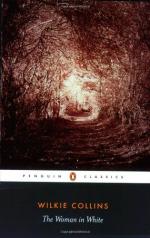A multitude of small considerations in connection with this subject—trifling enough in themselves, but strikingly important when massed together—had latterly led my mind to a conclusion which I resolved to verify. I obtained Marian’s permission to write to Major Donthorne, of Varneck Hall (where Mrs. Catherick had lived in service for some years previous to her marriage), to ask him certain questions. I made the inquiries in Marian’s name, and described them as relating to matters of personal history in her family, which might explain and excuse my application. When I wrote the letter I had no certain knowledge that Major Donthorne was still alive—I despatched it on the chance that he might be living, and able and willing to reply.
After a lapse of two days proof came, in the shape of a letter, that the Major was living, and that he was ready to help us.
The idea in my mind when I wrote to him, and the nature of my inquiries will be easily inferred from his reply. His letter answered my questions by communicating these important facts—
In the first place, “the late Sir Percival Glyde, of Blackwater Park,” had never set foot in Varneck Hall. The deceased gentleman was a total stranger to Major Donthorne, and to all his family.
In the second place, “the late Mr. Philip Fairlie, of Limmeridge House,” had been, in his younger days, the intimate friend and constant guest of Major Donthorne. Having refreshed his memory by looking back to old letters and other papers, the Major was in a position to say positively that Mr. Philip Fairlie was staying at Varneck Hall in the month of August, eighteen hundred and twenty-six, and that he remained there for the shooting during the month of September and part of October following. He then left, to the best of the Major’s belief, for Scotland, and did not return to Varneck Hall till after a lapse of time, when he reappeared in the character of a newly-married man.
Taken by itself, this statement was, perhaps, of little positive value, but taken in connection with certain facts, every one of which either Marian or I knew to be true, it suggested one plain conclusion that was, to our minds, irresistible.
Knowing, now, that Mr. Philip Fairlie had been at Varneck Hall in the autumn of eighteen hundred and twenty-six, and that Mrs. Catherick had been living there in service at the same time, we knew also—first, that Anne had been born in June, eighteen hundred and twenty-seven; secondly, that she had always presented an extraordinary personal resemblance to Laura; and, thirdly, that Laura herself was strikingly like her father. Mr. Philip Fairlie had been one of the notoriously handsome men of his time. In disposition entirely unlike his brother Frederick, he was the spoilt darling of society, especially of the women—an easy, light-hearted, impulsive, affectionate man—generous to a fault— constitutionally lax in his principles, and notoriously thoughtless of moral obligations where women were concerned. Such were the facts we knew—such was the character of the man. Surely the plain inference that follows needs no pointing out?




